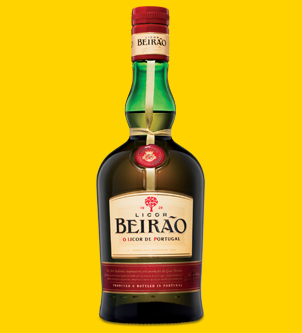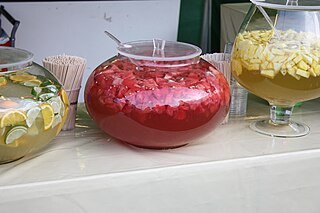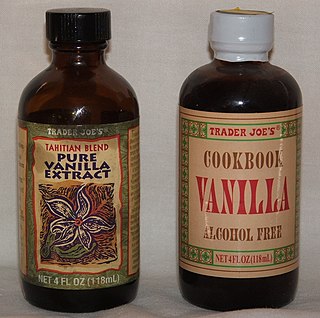
A liqueur is an alcoholic drink composed of spirits and additional flavorings such as sugar, fruits, herbs, and spices. Often served with or after dessert, they are typically heavily sweetened and un-aged beyond a resting period during production, when necessary, for their flavors to mingle.

A margarita is a cocktail consisting of tequila, triple sec, and lime juice. Some margarita recipes include simple syrup as well and are often served with salt on the rim of the glass. Margaritas can be served either shaken with ice, without ice, or blended with ice. Most bars serve margaritas in a stepped-diameter variant of a cocktail glass or champagne coupe called a margarita glass. The margarita is one of the world's most popular cocktails and the most popular tequila-based cocktail.

Costa Rican cuisine is known for being mostly mild, with high reliance on fruits and vegetables. Rice and black beans are a staple of most traditional Costa Rican meals, often served three times a day. Costa Rican fare is nutritionally well rounded, and nearly always cooked from scratch from fresh ingredients. Owing to the location of the country, tropical fruits and vegetables are readily available and included in the local cuisine.

Sloe gin is a British red liqueur made with gin and blackthorn fruits (sloes), which are the drupe fruit of the Prunus spinosa tree, which is a relative of the plum. As an alcoholic drink, sloe gin contains between 15 per cent and 30 per cent alcohol by volume (ABV); however, European Union regulations established 25 per cent ABV as the minimal alcoholic content for the blackthorn beverage to be a sloe gin. Historically, despite being a liqueur based upon gin, the EU included the colloquial name sloe gin to the legal definitions; thus, sloe gin is the only alcoholic beverage that legally uses the term gin without appending the liqueur suffix.

The term punch refers to a wide assortment of drinks, both non-alcoholic and alcoholic, generally containing fruits or fruit juice. The drink was introduced from the Indian subcontinent to England by employees of the East India Company in the late 17th century. Punch is usually served at parties in large, wide bowls, known as punch bowls.

Rice pudding is a dish made from rice mixed with water or milk and other ingredients such as cinnamon, vanilla, and raisins.

A sour is a traditional family of mixed drinks. Sours belong to one of the old families of original cocktails and are described by Jerry Thomas in his 1862 book How to Mix Drinks.

Salvadoran cuisine is a style of cooking derived from the nation of El Salvador. The indigenous foods consist of a mix of Amerindian cuisine from groups such as the Lenca, Pipil, Maya Poqomam, Maya Chʼortiʼ, Alaguilac and Cacaopera peoples. Many of the dishes are made with maize (corn). There is also heavy use of pork and seafood. European ingredients were incorporated after the Spanish conquest.

Coquito is a traditional Christmas drink that originated in Puerto Rico. The coconut-based alcoholic beverage is similar to eggnog, and is sometimes referred to as Puerto Rican Eggnog. The mixed drink is made with Puerto Rican rum, coconut milk, cream of coconut, sweetened condensed milk, vanilla, nutmeg, clove, and cinnamon.

An extract (essence) is a substance made by extracting a part of a raw material, often by using a solvent such as ethanol, oil or water. Extracts may be sold as tinctures, absolutes or in powder form.

Dominican cuisine is made up of Spanish, indigenous Taíno, Middle Eastern, African, Cuban, Puerto Rican and Haitian influences. The most recent influences in Dominican cuisine are from the British West Indies and China.

Cocktail garnishes are decorative ornaments that add character or style to a mixed drink, most notably to cocktails.

A "fizz" is a mixed drink variation on the older sours family of cocktail. Its defining features are an acidic juice and carbonated water. It typically includes gin or rum as its alcoholic ingredient.

A fruit cup, also known as a summer cup, is traditionally an English speciality drink designed to be made into a long drink with addition of a soft drink such as lemonade or ginger ale. Most commonly, these are gin-based, although there are some varieties based on other spirits such as vodka. The base gin is flavoured with various herbs, spices, fruits, and botanicals as well as its strength reduced. Fruit cups are typically marketed for the summer months, served with fruit as a cocktail garnish to the drink and to improve the flavour; recommendations include apple, orange, strawberry, lemon, lime, cucumber, mint, and borage leaves.
Lucas Bols N.V. is a Dutch public company in the business of production, distribution, sales and marketing of alcoholic beverages. It claims to be the oldest distillery brand in the world. Its brand portfolio consists of Bols, Galliano, Vaccari, Pisang Ambon, Gold Strike and a large group of Dutch genevers and liqueurs. It produces about 3 million cases a year, with yearly revenues exceeding 95 million euros.














